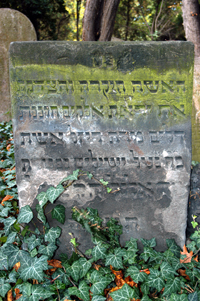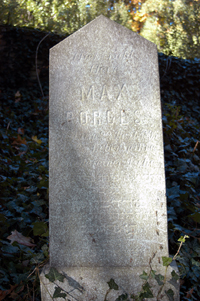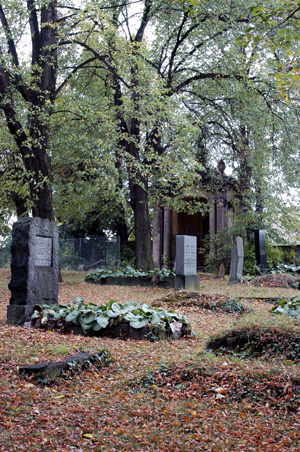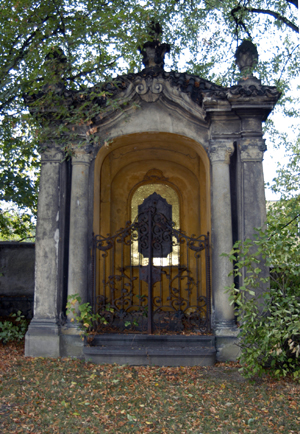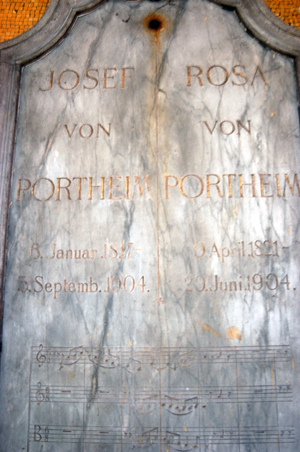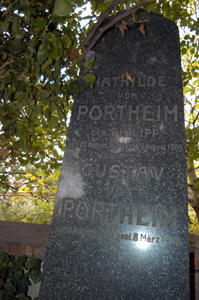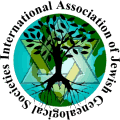|
The Jewish cemeteries of Prague
Praha - Josefov is located in Bohemia - Velka Praha
(Greater Prague, Czech Republic. The earliest known Jewish community in this town
was 11th century. The Jewish population was 35,425 people in 1930
in all Praha. The cemetery location is urban, on flat land, isolated, marked by a sign or plaque in local language Czech, a sign or plawue in Hebrew, inscriptions in Hebrew on gate or wall, inscriptions on pre-burial house Hebrew, no sign, but Jewish symbols on gate or wall. The marker mentions famous individuals buried in cemetery, Hevra Kaddisha. It is reached by turning directly off a public road. It is open to all on admission fee only, in opening hours. The cemetery is surrounded by a continuous masonry wall. There is a gate that locks. The approximate size of cemetery before WWII and now is 0.99 ha hectares. There are more than 5000 approximately 12,000 stones. The cemetery has special section with no detail given. Stones are datable from legible: 1346 (transferred from older cemetery; legible: 1439 (as original in this cemetery to 18th century. The cemetery has tombstones and memorial markers made of marble, limestone and sandstone. The cemetery contains tombstones that are flat shaped stones, flat stones with carved relief decoration and tumbas. Inscriptions on tombstones are in Hebrew. The cemetery contains no known mass graves. Within the limits of the there is a pre-burial house and there are other structures synagogue. The pre-burial house has wall inscriptions, a chimney and other distinctive features protected building of architectural value. The present owner of the cemetery property is the local Jewish community Praha. The cemetery property is now used for Jewish cemetery use only. Properties adjacent to it is commercial or industrial, residential and museum. The cemetery boundaries has not changed since 1939. The cemetery is visited frequently by organized Jewish group tours or pilgrimage groups. organized individual tours. private visitors. The cemetery has been vandalized prior to World War II reduced by 0.2 ha in 1903. No maintenance has been done. The work was done by local/municipal authorities, regional/national authorities and Jewish groups within country. Restoration was done in continuously after WWII. Now there is regular caretaker. The caretaker is paid by the Jewish congregation of Praha. Moderate threat: vandalism. Slight threat: uncontrolled access, weather erosion and vegetation. This survey was complete by Jiri Fiedler, Brdickova 1916, 155 00 Praha 5, tel. 02/553340 on 31 Aug 92. The following documentation was used to complete
this survey:
The cemetery location is urban, on flat land, isolated, marked by no sign or marker. It is reached by turning directly off a public road. It is open with permission. The cemetery is surrounded by a continuous masonry wall. There is a gate that locks. The approximate size of cemetery before WWII was 0.7956 ha and is now approx. 0.2 ha hectares. There are 100-500 stones all in their original locations. The cemetery has no special sections. Stones are datable from 1892 to 20th century. The cemetery has tombstones and memorial markers made of marble, granite, limestone, sandstone and slate. The cemetery contains tombstones that are flat shaped stones, finely smoothed and inscribed stones, sculpted monuments and multi-stone monuments. The cemetery has tombstones metal fences around graves. Inscriptions on tombstones are in Hebrew, German and Czech. The cemetery contains no known mass graves. Within the limits of the there is a pre-burial house sold. The present owner of the cemetery property is the local Jewish community Praha. The cemetery property is now used for Jewish cemetery use only. Properties adjacent to it is recreational and residential. The cemetery boundaries is smaller now than 1939 because of sports ground. The cemetery is visited rarely by private visitors. The cemetery has been vandalized occasionally, between 1981-91 and between 1945 and 1981. No maintenance has been done. The work was done by Jewish groups within country. Restoration was done in before 1985. There is no maintenance now. Moderate threat: vegetation. Slight threat: uncontrolled access, weather erosion and vandalism. This survey was complete by Martina Chmelikova, Nad Ondrejovem 16, 140 00 Praha 4, tel. 02/69-20-350 and Jiri Fiedler, Brdickova 1916, 155 00 Praha 5, tel. 02/553340 on 31 Aug 92. The following documentation was used to complete
this survey: census 1849, 1930; notes of Statni zidovske muzeum
Praha; Josef Polak: Zide v Libni ... in Kalendar cesko-zidovsky,
1912-1913; Bedrich Nosek: Die juedische Kultusgemeinde in Liben
in Judaica Bohemiae, year 16. Other documentation exists but was
not used because accessible. The site was not visited. No interviews.
Praha - Liben is located in Bohemia - Velka Praha Greater Prague, Czech Republic. The old cemetery is located at 3.4 km NE of center of Prague, close to eastern end of "Libensky most" bridge. It was also called Lieben in German. The town is located at 50.07' longitude and 14.30' latitude. The present town population is over 100,000 all Praha with 1,000 - 10,000 all Praha Jews. The earliest known Jewish community in this town was 16th century. The Jewish population was 801 people in 1930 in Liben. Noteworthy historical event(s) involving or affecting the Jewish community were First privileges of Jewish community in 1656; about 800 souls (approx. 30% of total population) in mid-19th century; decrease of Jewish population in 2nd half of 19th century moving to Prague or Vienna; town of Liben incorporated into Greater Prague in 1901; increase of both total and Jewish population in Liben in 20th century. Noteworthy individual(s) who lived in this Jewish community: Writer Voytech Rakous 1862-1935 lived here; native town of: Naftali Herz Homberg, pioneer of Haskala 1749-1841; conductor Rudolf Pekarek 1900-1974; writer Arnost Lustig, resident in Washington, D.C. b. 1926. The Jewish cemetery was established in probably 16th century. Tzadakkim and other noteworthy Jews buried in the cemetery were regional rabbi Jakov Haller 1808-1890; founders of industry in Liben and Karlin. The last known Jewish burial was in about 1892. The type of Jewish community which used this cemetery was probably Conservative. Karlin (German: Karolinenthal) 2 km used this cemetery. The cemetery is no protected til 1962t listed and/or protected as a landmark or monument. The cemetery location is urban, on flat land, on a hillside, isolated, marked by no sign or marker. It is reached by turning directly off a public road. It is open to all. The cemetery is surrounded by a broken masonry wall. There is no gate. The approximate size of cemetery before WWII and now is 0.4136 ha hectares. No stones visible. Stones are datable from buried: probably 17th century to 19th century. The cemetery has tombstones and memorial markers made of buried: marble, granite, limestone and sandstone. The cemetery contains tombstones that are buried: flat shaped stones, finely smoothed and inscribed stones, flat stones with carved relief decoration, multi-stone monuments and obelisks. The cemetery has tombstones buried: with traces of painting on their surfaces and portraits on stones. Inscriptions on tombstones are in buried: Hebrew, German and Czech. The cemetery contains no known mass graves. Within the limits of the there are no structures. The present owner of the cemetery property is the municipality. The cemetery property is now used for waste dumping. Properties adjacent to it is commercial or industrial and municipal transport. The cemetery boundaries has not changed since 1939. The cemetery is visited rarely by private visitors and local residents. The cemetery has been vandalized prior to World War II northern part liquidated for building of new bridge in 1925-1928, never in 1981-91 and between 1945 and 1981 covered by earth about 1965. No maintenance has been done. There is no maintenance now. This survey was complete by Jiri Fiedler, Brdickova 1916, 155 00 Praha 5, tel. 02/553340 on 31 Aug 92. The following documentation was used to complete this survey: census 1849, 1930; cadastre and maps of 1828, 1841, 1876, 1900, 1929; Josef Polak: Zide v Libni ... in Kalendar cesko-zidovsky, 1912-1913; and Bedrich Nosek: Die juedische Kultusgemeinde in Liben in Judaica; Bohemiae, year 16. The site was not visited. No interviews.
Praha 5 - Smichov is located in Bohemia - Praha, Czech Republic. This old cemetery is located at 4 km SSW of center of Prague, in "U stareko zidovskeko hrbitova" street. It was also called Smichow in German. The present town population is over 100,000 all Praha with 1,000 - 10,000 all Praha Jews. Town officials: Obvodni urad, referat kultury, Mayor: ing. arch. Petr Syrovy, nam.14. rijna 9, 150 00 Praha 5, tel. 02/540651 or 546461. Regional officials: Jewish congregation: Prazska ZNO Ms. Jana Wolfova, Maislova 18, 110 01 Praha 1, tel. 02/231-18664 and Przske stredisko, pamatkove pece, Male namesti 13, 110 01 Praha 1, tel. 02/2368344 or 52. Interested parties: Statni zidovske muzeum, Jachymova 3, 110 01 Praha 1 tel. 02/231-06-34 or 341-07-85 and Archiv hl. m. Prahy competent: Ph.Dr. Jiri Kudela, Husova 20, 110 01 Praha 1, tel. 02/228852. The earliest known Jewish community in this town was 1788. The Jewish population was 1,538 Jews in Smichov, 35,425 Jews in 1930 in all Praha. Noteworthy historical event(s) involving or affecting the Jewish community were Continuing increase of both total and Jewish population in Smichov since 18th century. Noteworthy individuals who lived in this Jewish community: Birth-place of MUDr. Siegfried Kapper 1821-1879, poet and founding father of Czech-Jewish movement; physicist Albert Einstein 1879-1955 lived there in 1910-1911. The Jewish cemetery was established in probably 1788. The last known Jewish burial was in 1921. The type of Jewish community which used this cemetery was probably Conservative. Kosire; Roztoky (German: Rostok) 2 km; 12 km. used this cemetery. The cemetery is probably listed as a landmark or monument. The cemetery location is urban, on a hillside, at the crown of a hill, isolated, marked by no sign or marker. It is reached by turning directly off a public road by a short forest pathway. It is open to all. The cemetery is surrounded by a broken masonry wall. There is a gate that does not lock. The approximate size of cemetery before WWII and now is 0.3613 ha hectares. There are 100-500 stones. Stones are datable from last quarter of 18th century to 20th century. The cemetery has tombstones and memorial markers made of marble, granite, limestone and sandstone. The cemetery contains tombstones that are flat shaped stones, finely smoothed and inscribed stones, flat stones with carved relief decoration, double tombstones, multi-stone monuments and column. The cemetery has tombstones metal fences around graves. Inscriptions on tombstones are in Hebrew and German. Within the limits of the there are other structures devastated grave-digger's house. The present owner of the cemetery property is the local Jewish community Praha. The cemetery property is now used for Jewish cemetery use only. Properties adjacent to it is recreational municipal grove, agricultural gardens and residential. The cemetery boundaries has not changed since 1939. The cemetery is visited occasionally by private visitors and local residents. The cemetery has been vandalized frequently between 1981-91 and between 1945 and 1981. No maintenance has been done. The work was done by individuals or groups of non-jewish origin, local/municipal authorities, Jewish individuals within country and Jewish groups within country. Restoration was done in 1980-81. There is no maintenance now. Serious threat: uncontrolled access, pollution and vandalism. Moderate threat: vegetation. Slight threat: weather erosion and existing nearby development. The site was not visited. People at the town archives; consultations in 1982-1988 were interviewed.
Praha 5 - Smichov is located in Bohemia - Praha, Czech Republic. The new cemetery is located at 4 km SW of center of Praha, in Peroutkova street. It was also called Smichow in German. The town is located at 50.03 longitude and 4..4 latitude. Praha 5 - Smichov is just in the city of Praha. The present town population is over 100,000 with 1,000 - 10,000 (all Praha) Jews. Town officials: Obvodni urad - referat kultury, nam.14.rijna 9, 150 00 Praha 5, tel. 02/540651 or 546461. Regional officials: Jewish congregation: Zno Praha (Ms Jane Wolfova), Maislova 18, 110 01 Praha 1, tel.02/2318664. Interested parties: Statni zidovske muzeum, Jacymova 3, 110 01 Praha 1, tel. 02/2310634. Caretaker: and person with the key Mr. Sedlacek, Peroutkova 2482, 150 00 Praha 5 - Smichov. The earliest known Jewish community in this town was 1788. The Jewish population was 1538 souls in Smichov, 35,425 in all of Praha in 1930. A noteworthy historical event involving or affecting the Jewish community were an increase of both total and Jewish population in Simchov since 18th century. Noteworthy individuals who lived in this Jewish community: Birthplace of MUDr Siegfried Kapper (1821-1879), poet and founding father of Czech-Jewish movement; physicist Albert Einstein (1879-1955) lived there in 1910-11. The Jewish cemetery was established in 1903. Tzadakkim and other noteworthy Jews buried in the cemetery were tombs of family Porges von Portheim (founders of Smichov textile industry)(see photos below); urn of Rudolf Fuchs (1890-1942), poet writing in German, translator of Czech poetry. The last known Jewish burial was in 1973; deposition of urns continues till today. The type of Jewish community which used this cemetery was Conservative or Progressive/Reform. Roztoky (Ger: Rostok) 12 km used this cemetery. The cemetery is probably not listed and/or protected as a landmark or monument.
The cemetery location is urban, on a hillside slight slope, separate, but near cemeteries, marked by no sign, but Jewish symbols on gate or wall - the iron gate is made in the shape of a sign or plaque in local language menorah. It is reached by turning directly off a public road. It is open to all. The cemetery is surrounded by a continuous masonry wall. There is a gate that locks (open 7am till 6pm). The approximate size of cemetery before WWII was 0.8404 ha and is now approx. 0.6 ha hectares. There are 100-500 stones, most in their original locations. The cemetery has no special sections. Stones are datable from 20th century. The cemetery has tombstones and memorial markers made of granite, sandstone and iron. The cemetery contains tombstones that are rough stones or boulders, finely smoothed and inscribed stones, multi-stone monuments and obelisks (angular- shaped columns). The cemetery has tombstones with bronze decorations or lettering and metal fences around graves. Inscriptions on tombstones are in Hebrew, German and Czech. The cemetery contains special memorial mounuments to the founding and founding fathers of cemetery. Within the limits of the there are other structures gravedigger's (caretaker's) house. The present owner of the cemetery property is the local Jewish community Praha. The cemetery property is now used for Jewish cemetery use only and agricultural use (crops or animal grazing) garden of caetaker. Properties adjacent to it is agricultural private gardens, municipal cemtery and modern Adventists church. The cemetery boundaries is smaller now than 1939 because of for building of adventist church after 1980. The cemetery is visited frequently by organized Jewish group tours or pilgrimage groups, private visitors and local residents. This cemetery has not been vandalized. No maintenance has been done. The work was done by Jewish groups within country. Restoration was done in continuously; new northern wall and gate after 1980. Now there is regular caretaker. The caretaker is paid by the Jewish congregation of Praha. The following documentation was used to complete this survey: Jarbuch fur die israelische Cultusgemeinden Bohmens (1893-94). Other documentation exists but was not used because not accessible. The site was not visited. Mr. Sedlacek & his wife in 1990 and 1992 were interviewed.
Praha - Zizkov is located in Bohemia, Greater Praha (Velka Praha), Czech Republic. This old cemetery is located at 2.5 km ESE of center of Praha, in Fibichova Street. The present town population is over 100,000 (all Praha) with 1,000 - 10,000 (all Praha) Jews. Town officials: Obvodni urad, Havlickovo namesti 9, 130 00 Praha 3, tel.02/27-47-44, mayor: tel.02/27-57-13; Magistratni urad, (mayor:Milan Kondr), marianske namesti 2, 110 01 Praha 1, tel.02/283-11-11 or 232-24-12. Regional officials: Prazske stredisko pamatkove pece, Male namesti 13, 110 01 Praha 1, tel.02/236-83-44 or 236-83-52; Prazska ZNO, Maislova 18, 110 01 Praha 1, tel.02/231-69-25. Interested parties: Statni zidovske muzeum, Jachymova 3, 110 01 Praha 1, tel.02/231-06-34 and Archiv hl.m.Prahy (competent:PhDr.Jiri Kudela), Husova 20, 110 01 Praha 1,tel.02/22/88/52. Key holder: Jewish congregation. The earliest known Jewish community in this town was 1888 (as zizkov). The Jewish population was 2188 souls in Zizkov, 35,425 souls in all Praha in 1930. Noteworthy historical events involving or affecting the Jewish community were autonomous locality Zizkov established in 1875, chartered in 1881, incorporated into Greater Prague in 1920; Jewish religious spciety established in 1888, as independent congregation about 1890; unceasing increase of Jewish population since 19th century; (history of Prague congregation in form "Praha-Josefov"). Tzadakkim and other noteworthy Jews buried in the cemetery were hundreds of renowned personalities famous rabbis as : Ezechiel Landau (1713-1793) and Solomon Rapaport (1790-1867). The last known Jewish burial was in 1891. The type of Jewish community which used this cemetery was Conservative or Progressive/Reform. City of Prague (eastern bank of river Vltava) used this cemetery. The cemetery is yes (no details were given)t listed and/or protected as a landmark or monument. The cemetery location is urban, on flat land, on a hillside, isolated, marked by inscriptions in Hebrew on gate or wall,inscriptions on pre-burial house. It is reached by turning directly off a public road. It is open with permission. The cemetery is surrounded by a continuous masonry wall. There is a gate that locks. The approximate size of cemetery before WWII was approx. 3.3 ha and is now approx. 0.5 ha hectares. There are 500-5000 (but over 37,800 buried bodies) stones, most in their original location. Stones are datable from probably late 18th century to 19th century. The cemetery has tombstones and memorial markers made of marble, granite, limestone and slate. The cemetery contains tombstones that are flat shaped stones, finely smoothed and inscribed stones, flat stones with carved relief decoration, sculpted monuments, multi-stone monuments, obelisks, tombs and tumbas- rough stones or boulders form of gravestone). The cemetery has tombstones with traces of painting on their surfaces and metal fences around graves. Inscriptions on tombstones are in Hebrew and German. The cemetery contains unmarked mass graves from plague epidemic in 17th and 18th centuries. Within the limits of the there is a pre-burial house house of Hevra Kaddisha, sold now and there is a wall. The pre-burial house has three memorial tablets outsides. The present owner of the cemetery property is the local Jewish community of Praha. The cemetery property is now used for Jewish cemetery use only. Properties adjacent to it is recreational, residential and tower of TV transmitter. The cemetery boundaries is smaller now than 1939 because of public park. The cemetery is visited occasionally by organized Jewish group tours or pilgrimage groups and private visitors. The cemetery has been vandalized occasionally, between 1981-91 (buried tombstones excavated and removed, preburial house sold in 1985) and between 1945 and 1981 (cemetery reduced and tombstones buried between 1956-1960). No maintenance has been done. The work was done by local/municipal authorities, regional/national authorities and Jewish groups within country. Restoration was done in continuously (e.g., 1976, early 1980's, 1986) with vandalism afterward. Now there is occasional clearing or cleaning by individuals by Jewish congregation. The following documentation was used to complete this survey: Jahrbuch fur die israelische Ciltusgemeinden Bohmens (1893-1894,1894-1895); David Lieben: Die Eroffnung des neuen Zweiten Israel, Wolschaner Friedhofes (1890) article in: Vestnik ZNO, 1980, No. 2. The site was not visited. No interviews
Praha - Zizkov is located in Bohemia, Greater Prague (Velka Praha). See Praha above for city and historical information., Czech Republic. This new cemetery is located at 3.5 km ESE of center of Praha, in "Nad vovodem" street. Caretaker: with key, ing.Artur Radvansky, Nad vodovodem 1 (caretaker's house), 130 01 Praha 3, tel.02/733-022. The earliest known Jewish community in this town was 1888 (as zizkov). The Jewish cemetery was established in 1890. Tzadakkim and other noteworthy Jews buried in the cemetery were hundreds of renowned personalities of all fields of activity:. The last known Jewish burial was in still used at present. The type of Jewish community which used this cemetery was Conservative, Progressive/ Reform. central cemetery for main terrior of Praha used this cemetery. The cemetery is listed and/or protected - no details were given. The cemetery location is urban, on a hillside, separate, but near cemeteries, marked by inscriptions in Hebrew on gate or wall, no sign, but Jewish symbols on gate or wall. It is reached by turning directly off a public road. It is open to all in opening hours. The cemetery is surrounded by a continuous masonry wall. There is a gate that locks. The approximate size of cemetery before WWII and now is approx. 10 ha hectares. There are more than 5000 (approx. 15,000 graves) stones all in their original location. The cemetery has special section for for urns). Stones are datable from 1890 to 20th century. The cemetery has tombstones and memorial markers made of marble, granite, limestone, sandstone and iron. The cemetery contains tombstones that are flat shaped stones, finely smoothed and inscribed stones, sculpted monuments, multi-stone monuments, horizontally set stones with Sephardic inscriptions (not Sephardic), obelisks and tombs and tumbas). The cemetery has tombstones with iron decorations or lettering, with bronze decorations or lettering, with other metallic elements, portraits on stones and metal fences around graves. Inscriptions on tombstones are in Hebrew, Yiddish, German, Czech, Slovak, Hungarian, French, English and etc). The cemetery contains special memorial mounuments to Holocaust victims, Jewish soldiers and to victims of catastrophe of the ship "Patria"; to the extinct congregation of Dolni Kralovice). The cemetery contains marked mass graves ashes from Teresin. Within the limits of the there is a pre-burial house and there are other structures building of custody of cemetery. The pre-burial house has a tahara, a catafalque, wall inscriptions, a chimney and other distinctive features protected buildings of architectual value. The present owner of the cemetery property is the local Jewish community Praha. The cemetery property is now used for Jewish cemetery use only. Properties adjacent to it is commercial or industrial, residential and Russian and military cemetery. The cemetery boundaries has not changed since 1939. The cemetery is visited frequently by organized Jewish group tours or pilgrimage groups, organized individual tours and private visitors. The cemetery has been vandalized occasionally, between 1981-91 (some stones stolen). No maintenance has been done. The work was done by local/municipal authorities, Jewish individuals abroad and Jewish groups within country. Restoration was done in continuously. Now there is regular caretaker. The caretaker is paid by the Jewish congregation of Praha. The following documentation was used to complete this survey: Jarbuch fur die israelische Cultusgemeinden Bohmens (1893-94; 1894-95); article in: Vestnik ZNO, 1980, No.2; Frantisek Kafka: Novy zidovsky hrbitov v Praze (1992). Other documentation exists but was not used because meanwhile not accessible. The site was not visited. Ing.A.Radvansky, Praha, 1992 was interviewed.
Date: Fri, 28 Jan 2000 16:01:22 -0500 Those of you who have traveled to Prague have no doubt visited the old Jewish cemetery in the center of town, where the Maharal Rabbi Loew and many others are buried; and some of you may have also visited the New Olsany Cemetery further out in the Zizkov district, where Franz Kafka and others are buried; but probably not many of you have ever visited the Old Olsany (Alt Olschany) Cemetery in Zizkov. Here are some descriptions of the cemetery and its history that I obtained when I inquired why the graves of so many of my ancestors and relatives were no longer there: During the devastating plague epidemic in the years 1679 and 1680 Prague had to found new burial grounds where increasing numbers of dead could be buried in mass graves. On January 16, 1680, Prague's municipal authorities gave the Jewish community permission to bury its dead on a lot situated one mile away from town -- about midway between the New Town fortifications and the simultaneously founded Catholic plague burial ground near the village of Olsany. Along with the cemetery, the Jewish community also founded a field hospital to which some Jewish inhabitants infected with the disease were transported from the ghetto. During the epidemic, some 3,000 dead were buried in mass graves at the cemetery. It was re-used temporarily during the plague of 1713 (another 3,388 buried corpses) and during the expulsion of the Jewish population from Prague 1744-1748. When the interment was prohibited in town centers under Emperor Joseph II, this plague burial ground replaced the officially closed Old Cemetery in the Jewish Town to become Prague's main Jewish cemetery on June 1, 1787. Since some 250-400 graves were added every year, it was necessary to buy land in the vicinity to expand the cemetery. In two hundred years from 1680, the cemetery grew nearly five times its original size. In the second half of the 19th century, however, the cemetery was approached on two sides by new houses built in the fast-growing towns of Zizkov and Vinohrady which resulted in the prohibition of burials in 1891 for sanitary reasons. The abolished Old Olsany Cemetery was situated in the quarter of Zizkov, in the area between today's Fibichova and Ondrickova streets. During the Nazi Protectorate when it was prohibited for Jews to enter public parks, Jewish mothers with baby carriages would go there for a walk and children would play there. During the May revolution, on the contrary, the cemetery became the last refuge for Nazis -- they hid in tombs, shooting around. In the end, the cemetery was conquered by armed young Jews most of whom were members of a Zionist sports club. Several Nazis killed at the cemetery were also buried there. But the very last and somewhat unusual burial took place on February 19, 1948; 180 damaged Torah scrolls that had been taken to Czechoslovakia by the Nazis from the Netherlands were buried there with full honors, and with the assistance of two rabbis. The Old Olsany Cemetery holds some 37,800 deceased. They include many respectable figures such as rabbis and scholars, physicians, artists, public officials and even noblemen. Some of the most significant are Prague's Chief Rabbi Ezechiel ben Jehuda LANDAU (1713-1793) whose Classicist tomb is still frequently visited by many foreign visitors; Head of the Rabbinical Collegium Eleazar ben David FLECKELES (1754-1826), Moravia's Landesrabbiner Nehemias ben Selig TREBITSCH (1779-1842), historian and teacher Peter BEER (1755-1838), Chief Rabbi Solomon Judah Loeb RAPOPORT (1790-1867) and mathematician Jacob KOREF (1790-1852). Also founders of the first industrial factories are buried at the cemetery such as Leopold JERUSALEM (1789-1842), Aaron Beer PRIBRAM (1781-1852) and Salomon PRIBRAM (1808-1865), or Leopold PORGES von Portheim (1781-1870). The surrounding wall was torn down in 1960 and a greater part of the cemetery was changed into the so-called Mahler Park. Only the northern-most -- the oldest -- part of the cemetery with the most valuable tombstones and the adjacent building of the former field hospital was left untouched, to be surrounded by a new wall and restored in 1986-1987. Nevertheless, the Mahler Park does not exist any longer either; between 1985 and 1990 a new tower of Prague's television transmitter was constructed on the site and a large number of tombstones were dumped during excavations. In 1997, Eugen Stein, in his capacity working for the Jewish Community of Prague, answered an inquiry I had made to Radio Prague (owners of the transmission tower standing on the location of the former cemetery): It is your opinion that "Radio Prague" carries the guilt for the almost complete annihilation of these valuable objects. I am not sure if you can imagine the methods of the former regime. On the part of Radio Prague there was nothing to venture or decide. And the people who at that time lead the Prague Jewish community served under the dominion of the ruling body of the communist party. They did in fact send a protest letter, but that was all. Against the rubric of the "public interest" one could not do much. You asked, what happened to all the gravestones. When initially a park was created, the gravestones were buried with rites in pits on the cemetery grounds. Later during the building of the tower they were excavated and destroyed. Mr. Stein also told me that records of burials in the cemetery could be found in the death records in the State Archives, as well as in the Prague Jewish Museum. Mr. Stein also sent me a brochure from a fund-raising appeal by the Prague Jewish Community seeking $26,300 to restore the remnants of the Old Olsany Cemetery and make it open to the public. Donations could be sent to 1. At the Czech crown account: 2. At the USDollar account: E. Randol Schoenberg Los Angeles, CA
Uhrineves (part of the town of Praha) is located in Bohemia - Greater Prague. The cemetery is located at 1 km N, between Vachkova Str. and Vbytovkach Str. It was also called Aurinowes; Aurschinewes in German. Uhrineves (part of the town of Praha) is 14 km SE of centre of Prague. The present town population is 5,000 - 25,000 with probably under 10 Jews. Town officials: Mistni urad Uhrineves, namesti Bratri Jandusu 10, 251 61 Praha 10, tel.02/75-03-06; magistrate tel.02/75-93-04. Regional officials: Obvodni urad, referat kultury, Vrsovicka 68 101 00 Praha 10, tel. 02/73-69-51 or 02/73-95-51, magistrate: tel. 02/73-28-74; and Zidovska nabozenska obec, Maislova 18, 110 01 Praha 1 (Ms. Wolfova). Interested parties: Statni zidovske muzeum, Jacymova 3, 110 01 Praha 1, tel. 02/231-07-85 or 02/231-06-34. The earliest known Jewish community in this town was early 18th century. The Jewish population was 55 people in 1930. Noteworthy historical event(s) involving or affecting the Jewish community were moving of Jews to big towns in 2nd half of 19th century. The Jewish cemetery was established in early 18th cent. The last known Jewish burial was in probably about 1946. The type of Jewish community which used this cemetery was Conservative or Progressive/Reform. Ricany 6 km used this cemetery. The cemetery is listed and/or protected as a landmark or monument. The cemetery location is suburban, between fields and woods, on flat land, isolated, marked by no sign or marker. It is reached by turning directly off a public road. It is open to all. The cemetery is surrounded by a broken masonry wall. There is a gate that locks. The approximate size of cemetery before WWII and now is 0.3284 ha hectares. There are 100-500 stones, most in their original location. Stones are datable from legible 1719 to 20th century. The cemetery has tombstones and memorial markers made of marble, granite, limestone and iron. The cemetery contains tombstones that are flat shaped stones, finely smoothed and inscribed stones, flat stones with carved relief decoration and multi-stone monuments. The cemetery has tombstones with traces of painting on their surfaces and metal fences around graves. Inscriptions on tombstones are in Hebrew, German and Czech. The cemetery contains special memorial mounuments to Holocaust victims tablet with inscription stolen. Within the limits of the there are no structures. The pre-burial house has other distinctive features original paintings. The present owner of the cemetery property is the local Jewish community Praha. The cemetery property is now used for Jewish cemetery use only. Properties adjacent to it is recreational and commercial or industrial. The cemetery boundaries has not changed since 1939. The cemetery is visited occasionally by private visitors and local residents. The cemetery has been vandalized occasionally, between 1981-91 and between 1945 and 1981 many stones removed in 1984 by Jewish congregation. No maintenance has been done. The work was done by Jewish groups within country. Restoration was done in about 1970. There is no maintenance now. Very serious threat: vandalism. Moderate threat: vegetation. Slight threat: weather erosion, pollution and existing nearby development. This survey was completed by Jiri Fiedler, Brdickova 1916, 155 00 Praha 5, tel.02/553340 on 29 May 1992. The site was not visited. No interviews.
Several books about Prague are in Jerusalem and
listed in "Printed Books on Jewish cemeteries in the Jewish National
and University Library in Jerusalem: an annotated bibliography",
The Israel Genealogical Society, Jerusalem 1997; by Mathilde Tragger.
Some books are in the collection at the Jewish
Museum of Belgium. The contact is: Daniel Dratwa; e-mail: d.dratwa@mjb-jmb.org
Andenken an den alten israelitscher Friedhof und seine Umgebung in Prag (In memory of the old Jewish cemetery in Prague and its neighborhoods), by D. Podiebrad. Prague, no date. 2 pages, illustrated, German. L1880. Notes: 7 tombstones, 1439-1770, photograph only. source: MT Antiquitates judaicae pragenses; jurze erlaeuternde Notizen (Jewish antiques in Prague; short explanatory notes), Prague, 1900. 13 pages, German & Latin title.s77B1722. Notes: 18 tombstones, 1476-1787, Rabbis short biographies. source: MT Cemetery list source: Leo Baeck Institute donated
by : H. Jacobson, 1969 identified there as: Finding Aids: 39-page
inventory; Period covered (or date of publication) : 1660-1958;
Size of the collection: 18 feet 37 reels. Der alte Judenfriedhof in Prag/ Praha: Kollmann, Ludwig Verlag der Israelitischen Beerdigungs-Bruederschaft, 191-? 9p. illus. 18cm. ID # GT 3248 P7 K65 [LBI] Der Alte Prager Judenfriedhof (The old Jewish Cemetery
of Prague). Der alte juedische Friedhof in Prag (The old Jewish
cemetery in Prague), by the Prague Zidovske museum. Der alte Judenfriedhof in Prag (The old Jewish
cemetery in Prague). Der alte Prager juedische Friedhof (The old Jewish cemetery of Prague), by A. Kohut. Prague, 1897. 112 pages, Gothic German. 29V4837. Notes: 170 inscriptions, 13th century - 1712. Names are included in the text so it is impossible to know how many persons are mentioned, special chapter for women, cemetery history, Prague Jewish history. source: MT Der Alte Juedische Friedhof in Prag,1010, book000084, 1/5/1983, HERMAN Jan, title:,Das Staatbookche Juedische Museum in Prag,, 1966, 39 p.,German, source: DD Der Alte Juedische Friedhof in Prag,2201, book000279, 1996/0/604, Jakobovits Tobias, title:, Ein Fuehrer durch den Friedhof und seine wichtigsten Denkwuerdigkeiten aus dem XIV - XIX Jahrhundert , Das Staatbookche Juedische Museum in Prag,, 1960, 22 p., German, source: DD The Old Jewish exhibition of Prague. Volume III,1121, book 000196, 1/11/1983, Volavkova Hana, title:, A guide through the exhibition and a selection of its most important memorials from the XIVth - XIXth century, The Jewish Museum of Prague,, 1947, 15 p.,English, source: DD Die Eroeffnung des neuen zweiten Israel. Wolschaner Friedhofes am 6 Juli 1890; Beitrag zur Gerschichte des ersten Israel. Friedhofes in Wolschan (The opening of the second new Jewish cemetery in Prague Wolschan Olsan district] on July 6, 1890; a contribution to the history of Olsan first Jewish cemetery), by N. Ehrenberg and D. Lieben. Prague, 1890. 37 pages, German. S37B382. Notes: 100 tombstones, 1747-1889, chronology, short biographies including dates. source: MT Die Familien Prags. [Epitaphein des Alten Juedische
Friedhofs in Prag] Pressburg, 1892 (402+36p, in German and Hebrew (22,000 tombstone inscriptions, 9th-19th centuries) in the Hebrew College Library in Brookline, MA Die Inschriften des alten Prager Judenfriedhofes (The inscriptions in the old Jewish cemetery in Prague), by L. M. Popper and W. M. Popper. Braunschweig 1893. 42 pages, Gothic German and Hebrew inscriptions. 29V4849. Notes: 170 names, 1618-1785 (1 - 1546), non-alphabetical order by professions or nicknames, no index. source: MT Gal-Ed. Grabsteininschriften des prager isr, alten Friedshofs mit biographischen Notizen (Prague old jewish cemetery epitaphs, added biographical notes); by Liebsn, Koppelmann (Kaloan); Prague, 1856. [226]p. (German & Hebrew); Notes: Period: 941-1787. 170 tbsts. German index of personal nanes. source: National and University Library, Jerusalem Ktovot mibeit ha'almin hayehudi ha'atik beprag (Epitaphs from the old Jewish cemetery in Prague), by O. Muneles. Jerusalem, 1988. 501 pages, illustrated, Hebrew and English title page & contents. S88A2184. Notes: 247 tombstones, 1444-1877, biographical notes in Latin and Czech, names index, index of persons mentioned in inscriptions, index of outstanding persons and tombstone location, index of personal names, bibliography. source: MT Novy Zidovsky Hrbitov = neuer juedischer friedhof = New Jewish Cemetery = nouveau cimetiere juif // Frantisek Kafka. Praha, Nakl. MARSYAS, [1991] 71 p. illus. 25 cm. ID # GT 3248 P7 K3 [LBI] Old Prague Jewish cemetery, Photographieni Jan Lukas.; by Jindrich Lion; Published: Praha Artia, 1960. Title and text in German, English and French. 325.25693 L954 "Nouveau Cimetière Juif de Prague - Monument Culturel Protégé",237, article p.000237, 6/15/1990, KAFKA Frantisek, title:, "in Judaica Bohemiae, Volume XXIII/2", Judaica Bohemiae ,, 1987, pp. 101-113,F, source: DD Staronova Synagoga a Stary Zidovsky Hrbitov/Herman, Jan. Praha: Obelisk, c1972. [15]p. col. plates. 40cm. Cover title. Text in Czech, Russian, French, German and English. ID # f GT 3248 P7 H47 [LBI] Stary idovsk H bitov v Praze (The old jewsih cemetery in Prague), by O. Muneles and M. Vilimkova. Prague, 1955. 480,39 pages, Czech and Hebrew inscriptions. 56B1390. Notes: 170 tombstones, 1434-1588, men and women, inscription analysis, general index. source: MT "tanu ez a kohalom" (This Cairn is Witness Today), a very interesting book of Jewish Cemetery Photographs; published in Hungary in 1993. It is by Saros Laszlo and Vali Dezso. ISBN 963 7476 172. I have listed below the cemeteries contained, and the number of photographs of each. The vast majority of this 149 page book contains Black and White photographs. There are 8 (English) pages of text with general information. The sections are: Introduction, Cemetery in Ancient Times, Old Tombstones, Cemetery and History, The Tombs of the Ancestors, Tent and Parchment, People and Flower, Rituals of Death, Epitaphs, Signs and Symbols I. Symbols II. Animal and Vegetal (sic) Symbols III. Hebrew Abbreviations Bibliographical Notes There are 11 pictures of Prague A picture can be found at: http://www.andel3w.dk/prague/english/pragt09.htm "The Topographics of the Pictures Collection of the State Jewish Museum. II. The Old Jewish exhibition cemetery in Prague in the Pictures, reviews of Romantic artists of the 19th ",358, article p.000359, 6/19/1990, ParticleIKarno, title:, "in Judaica Bohemiae, Volume XIX/2", Judaica Bohemiae, 1983, pp. 99-111,ANG, source: DD The old Jewish cemetery of Prague: a guide through the cemetery and a selection of its most important memorial from the XIVth-XIXth centuries, by the Prague Zidovske museum Prague, 1947. 15,40 pages, plates, illustrations, map. 50B908. Notes: 36 tombstones list, 1349-1769, tombstone photographs (some readable), cemetery history. source: MT The New Cemetery: The New Jewish Cemetery, Prague 1, 3-Strasnice, Nad vodovodem 1. Contains the grave of Franz Kafka. source: The Jewish Travel Guide, 1992; Published by the Jewish Chronicle-London. Compiled by Bernard Kouchel, JGS of Broward County, PO Box 7251, Fort Lauderale, Florida 33318 USA. The cemetery was large enough to accommodate the needs of Prague Jewry, so new graves were piled upon the old although the cemetery was closed in 1737. The oldest preserved tombstone is that of the scholar and poet Avigdor Karo, who died April 25, 1439. Other identifiable tombstones include Rabbi Loew (Yehuda Levi Ben Bezalel, also know as the Maharal; David Gans, a Renaissance astronomer (1613); and Mordechai Maisel, mayor of the Prague Jewish community from 1528 to 1601. The thousands of tombstones, thrusting from the ground in clusters, resembles the leaves of an artichoke; most are elegantly carved and lettered. Source: "World Guide for the Jewish Traveler", by Warren Freedman, E.P. Dutton Inc, NY 1984. Extracted by Bernard Kouchel; JGS of Broward Co., Florida; March 1994. Old Jewish Cemetery, the oldest in Europe, containing the graves of such famous rabbis and scholars as Avigdor Caro (died 1439), Yehuda Low ben Bezalel (1609), David Gans (1613) & David Oppenheim (1736). The New Cemetery: Burials dating from about 1890 to the present. The caretakers were very helpful and provided books showing the names, location of burial plots and other family information. The cemetery is in the OLSANY section of the city. It can be reached by using the Metro line train "A" to the ZELIVSKEHO station. Incidentially Franz Kafka is buried there as well as his parents. source: Nat Abramowitz lucynat@aol.com In Prague, the Jewish cemetery we saw is the one where bodies are buried 12 deep. There are about 12.000 gravestones there in a very small area. Our tour guide there was Sylvia Wittmanova from Wittman Tours, the Jewish tourist agency in Prague. source: Lawrence Riesenbach e-mail: Riesenbach@aol.com |
